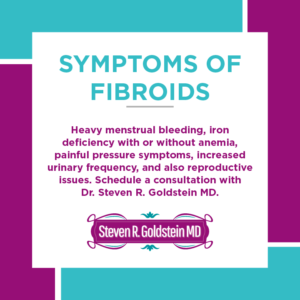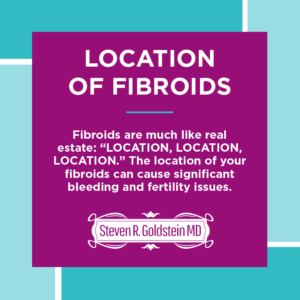Dr Steven R. Goldstein is a leading Gynecologist for Fibroids in NYC. Uterine Fibroids are the most common benign pelvic tumors. According to the Office on Women’s Health, Fibroids are most common in women in their early 40’s and 50’s. They are hormonally responsive to estrogen, so they will never be seen in women who have not yet had their first period. After menopause, when estrogen is no longer produced, these uterine fibroids will shrink in size.
Many women, however, seem to be unaware of their fibroids and their impact on their health. Recent study suggested that the average woman does not seek treatment for a mean of 3.6 years and 41% saw at least two healthcare providers before being properly diagnosed.
Between 25-50% of women can experience symptoms especially heavy menstrual bleeding, iron deficiency with or without anemia, painful pressure symptoms, increased urinary frequency, reproductive issues, pelvic pressure, abnormal uterine bleeding. If you are pre menopausal, or had pregnancy failures, then thorough systematic evaluation is warranted says Dr Goldstein, a top Gynecologist for Fibroids in NYC.

Dr Goldstein, a leading Gynecologist for Fibroids in NYC says true Fibroids have no malignant potential (they will not become cancerous). It was once thought that less than 1% could become cancer, but this does not occur. Fibroids are not cancerous, nor do they increase the risk of a woman having uterine cancer.
What can be diagnosed as cancerous are sarcomas, which are rare malignant tumors of the uterine muscle. These are not fibroids. They are almost always solitary rather than multiple. They can be distinguished from fibroids by using color flow Doppler Ultrasound technology. The blood flow will show a vascularity pattern very different from typical fibroids.
Typical fibroids have a circumferential pattern of blood flow with very little vascularity centrally located. Some benign fibroids can have vascularity if they are extremely cellular and still be benign.
There are different types of fibroids.
Intramural – these are the most common type of fibroids and occur within the wall of the uterus
Submucosal – A fibroid that protrudes into the endometrial cavity (within the uterus)
Subserosal – A fibroid that has a bumpy surface on the outside of the uterus
Pedunculated – a fibroid that has grown from from a subserosal fibroid outward
Degenerating
Fibroids can be a source of failed pregnancy (miscarriage). When such pregnancy failure occurs, thorough evaluation with transvaginal ultrasound and sometimes saline infusion sonohysterography is essential to be sure that the uterus is, in fact, normal and may not be the culprit for the failed pregnancy.
Fibroids can be a major source of bleeding especially in women as they age and get beyond the reproductive years. Women who have intermenstrual bleeding or heavy menstrual bleeding at the appropriate time may often be due to fibroids. However, there are a number of other causes that can be non fibroid-related and still result in such abnormal bleeding.
Fibroids are so common and so easily visualized on transvaginal ultrasound that understanding the difference between incidental and significant fibroids is paramount.Dr Goldstein says that “fibroids are like fingerprints, no two are ever alike.” In addition, fibroids are much like real estate: “LOCATION, LOCATION, LOCATION.”
Even small fibroids that impinge on the endometrial cavity (lining) can cause significant bleeding and fertility issues even when they are relatively small whereas, sometimes, rather large fibroids originating in the muscle and growing outward may have no impact whatsoever on bleeding, fertility, and patients may be totally unaware until examined.
Read more on transvaginal ultrasounds

Fibroids are so common and variable in size and location that clinical management and recommendations depend on many variables such as age, whether there are plans to get pregnant in the future, bleeding pattern, whether the patient is premenopausal or post menopausal.
Therapies are for uterine fibroids include goadotropin-releasing hormone agonists to help shrink the fibroids etc. There are also surgical options such as:
Hysterectomy – a surgical procedure to remove the womb
Myomectomy – surgery to remove the fibroids from the wall of the womb
Hysteroscopic resection of Fibroids – A hysteroscope and small surgical instruments are used to remove the fibroids
There are also several non-surgical procedures such as uterine artery embolisation (UAE), Endometrial Ablation, and procedures using MRI.
Dr. Goldstein will use painless Transvaginal Ultrasounds to help diagnose the cause of any symptoms of fibroids, heavy bleeding, etc. He personally does these transvaginal ultrasounds and is known as one of the most skilled operators in the world.
Dr Steven R. Goldstein is one of the most highly regarded individuals in the field of gynecologic ultrasound. His research over the decades has had a significant impact on the way gynecology is practiced, as much of it was adapted as the standard of care for so many gynecological concerns.
After the examination, any procedures, and you are dressed, Dr Goldstein will personally go over your condition, explain everything about it, treatment options and then answer all your questions. The visit is over when you are fully comfortable with everything. Please allot at least one hour for your visit. There is little to no wait time since Dr Goldstein does not overbook his office.
Schedule an appointment below.
appointment request